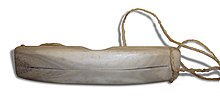Snow safety includes precautions in snowy terrain, except those for cold weather.
Avalanches

Avalanches are a danger of mountain areas. At winter resorts the risk of avalanches is monitored and warnings given when the risk is high.
Most accidents happen when people go downhill off piste – the risk of being a victim of a spontaneous avalanche is much smaller than the risk of actually causing an avalanche (or getting in the way of one started by others). When the risk is high, also spontaneous avalanches will still happen.
In addition to off piste skiing, any other disturbance may start an avalanche, e.g. driving a snowmobile – even just shouting.
If going off piste despite warnings you should know how to evaluate the current risks, have safety equipment and know how to increase your survival chances would you be unlucky.
Risk factors
- Layered snow
- Snowfall
- Rising temperature and sunlight
- Skiing
Safety equipment
In case of an avalanche
Covered dangers
Snow covers features of the landscape, including clefts, streams and other dangers. Be sure to know where you are to avoid them, rather than relying on what you see. On glaciers rope is used to stop somebody falling into a cleft, but this requires some know-how, for best protection and to avoid everybody being dragged into it. Do not go near the rim of a drop, as the snow may extend further than the cliff, or may collapse.
Low visibility
Thick snowfall can bring visibility down to a few metres. Even light snowfall considerably lessens visibility, so that distant landmarks can get out of sight. Wind-drift lower visibility in a similar manner near the ground.
Snow blindness

Snow blindness is a variant of ultraviolet keratitis, caused by extreme levels of ultraviolet light reflected by snow, similar to sunburn. Sunglasses with good UV protection are the very least you should do to protect yourself. Emergency lenses can be made by cutting slits in dark fabric or tape folded back onto itself.
Symptoms usually come hours after the exposure. Treatment is covering the eyes to let them rest, and possibly pain relief (remove contact lenses). Trekking as blind is not nice, but may be better than worsening the condition. Consider stopping as soon as you can at safe shelter to recover (with eyes covered). The eyes usually recover in one to three days.
